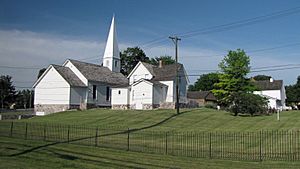Troy Historic Village facts for kids
 |
|
| Location | 60 W. Wattles Rd., Troy, Michigan |
|---|---|
The Troy Historic Village is a special place in Troy, Michigan. It lets visitors step back in time to see what life was like in Troy Township during the 1800s. Imagine living without phones or computers! The village has many old buildings that have been carefully fixed up. These include the main City Hall, a cozy log cabin, a fancy Greek Revival home, a one-room brick school, a print shop, a wagon shop, a town hall, a general store, and even a church and its parsonage from the early 1900s. It's like a living museum where history comes alive!
Contents
- Exploring the Historic Buildings
- Main Building: City Hall's History
- The Print Shop: News from the Past
- Caswell House: A Greek Revival Home
- Old Troy Church: A Place of Worship
- Log Cabin: Pioneer Life
- Wagon Shop: Tools and Transport
- General Store: Village Supplies
- Parsonage: Home for Ministers
- Troy Town Hall: From School to Meeting Place
- Poppleton School: Learning in the Past
Exploring the Historic Buildings
The Troy Historic Village is made up of several important buildings. Each one tells a unique story about the past.
Main Building: City Hall's History
The main building was once called Troy Township Hall. It was designed by an architect named J. Bissell and finished in 1927. A leader named Morris Wattles decided it should look like an old Dutch colonial tavern from Troy, New York. After it was built, the museum officially opened inside this building in 1966.
The Print Shop: News from the Past
This shop belonged to J. Henry Russell. He was a skilled craftsman who worked with wood and metal. He also took photographs! The print shop was where important things like posters, calling cards, and public announcements were made. The building itself used to be Troy Township's old water meter station. It was changed into the print shop for the village in 1978.
Caswell House: A Greek Revival Home
The Caswell House was built in 1832 by a pioneer named Soloman Caswell. It's called a Greek Revival home because of its balanced windows and decorative trim. This house was typical for the 1800s. It had stovepipes to help heat all the rooms. There was even a dry sink for washing dishes. Food was kept in special cabinets with tin panels to keep flies away.
Old Troy Church: A Place of Worship
This church was built in 1837 at Troy Corners. The land for the church was sold for just one dollar by pioneer Johnson Niles! Around 1900, new stained-glass windows were added. However, many of the original windows are still there today. The church became part of the Methodist Episcopal community in 1862. It served as the village's main church until 1963. The original church bell is still ringing today!
Log Cabin: Pioneer Life
The Log Cabin is a simple, one-room home. It shows what life was like for pioneers in the 1840s. Inside, there's a fireplace that was used for both warmth and cooking meals. Mothers would do handwork, like sewing, while rocking their babies in a cradle. Parents slept on beds made of rope, while the children slept in the loft on straw mattresses covered with warm quilts.
Wagon Shop: Tools and Transport
The Blacksmith at the Wagon Shop made important iron tools for farms. They also created household items and parts for wagons. The blacksmith worked closely with the village's woodworkers to build wagons and other useful objects.
General Store: Village Supplies
Edward Peck built the town's general store in 1832. The original store was taken down in 1963. However, a new building was later built to look just like the old general store. Inside, you can see examples of items that were sold long ago, like a cast-iron stove.
Parsonage: Home for Ministers
The Parsonage is a cross-shaped house that was built in 1978 by the Troy Methodist Church. It was home to more than 25 ministers and their families over the years. The building has been restored to look like it did in 1910, when indoor plumbing and electricity first became available.
Troy Town Hall: From School to Meeting Place
The Troy Town Hall was first built as the Troy Union School in 1864. In 1987, the school building was moved to the Village. Today, it represents Troy's very first town hall and is used as a hands-on learning area for visitors.
Poppleton School: Learning in the Past
Poppleton School was built in 1877. It was named after William Poppleton, who owned a lot of land in Troy. Children aged 8 to 14 attended this school. Only one teacher taught all the subjects, including reading, math, spelling, and handwriting. Boys sat on one side of the classroom, and girls sat on the other. Poppleton School was moved to the Village in 1980.

